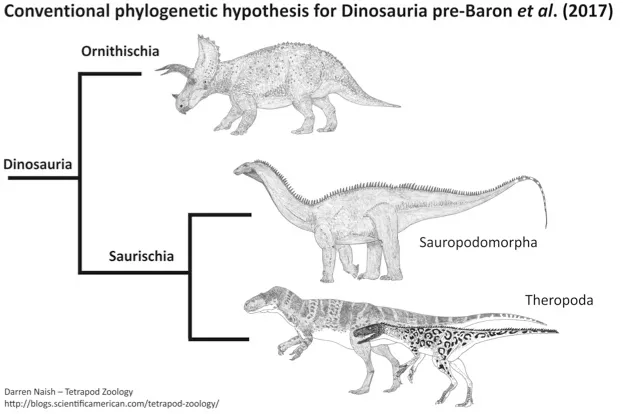Scientists have changed the dinosaur family tree during their research resulting in theropods (such as Tyrannosaurus) being more closely related to ornithischians (such as Stegosaurus) than to sauropodomorphs (such as Diplodocus).
The recent study has made waves in the palaeontology community by arguing that the previously accepted hypothesis, which was published about 130 years ago by Harry Seeley, was wrong.
“When we got the results we were surprised, but cautious; we knew this would be a controversial idea,” said lead author Matt Baron.
“We welcome criticism and we want people to test our data, but some people are just upset because they didn’t know that this was coming at all and it goes against their own work.”
In Seeley’s hypothesis, the dinosaurs are split into two groups (called clades) according to the structure of their hips, either ‘bird-hipped’ or ‘lizard-hipped’.

The conventional hypothesis proposed by Harry Seeley © Darren Naish
The former included Ornithiscia, while the latter included Sauropodomorpha and Theropoda (collectively called Saurischia).
For the new hypothesis, the scientists spent three years collating the datasets and months analysing them, and believe that most of Therapoda ought to be in the same clade as Ortnithiscia (this clade has now been renamed to Ornithoscelida).
"The new study is impressive overall," says palaeotonlogist Dr Darren Naish, "it involved first-hand analysis of numerous key specimens and the examination and collection of hundreds of pieces of anatomical data."
"A shakeup of this sort is a bit of a shock given the long tradition of classifying sauropods and kin together with theropods (predatory dinosaurs and birds). However ... people have been saying for a while that some early ornithischians do look somewhat theropod-like in a few aspects."
"Of course, this is just one study, and numerous additional work will now be done to see how robust it is. I definitely think the authors are on to something."
Their findings also suggests that dinosaurs may have first originated in the northern hemisphere in ancient supercontinent Laurasia, rather than Gondwana as previously proposed.
The paper was published in Nature, and can be viewed online via ReadCube.

